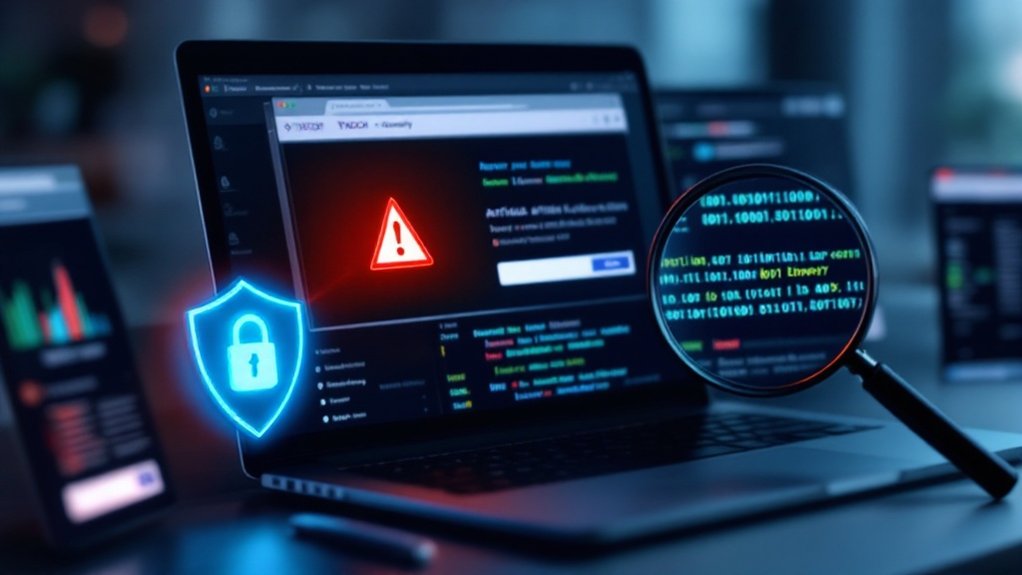A logic bomb is malicious code that remains dormant within software systems until specific trigger conditions activate its destructive payload. Unlike typical malware, these cyber weapons require predetermined criteria, such as dates or events, before executing harmful actions that can crash systems, corrupt data, and create unauthorized access points. Recent incidents, including the 2019 Siemens Corporation threat and 2023 Newag train sabotage, demonstrate how logic bombs pose significant risks to organizational security, network integrity, and operational stability. Understanding their mechanisms reveals critical vulnerabilities in modern cybersecurity frameworks.

The insidious threat of logic bombs continues to pose significant challenges for cybersecurity professionals worldwide, as these malicious code fragments lie dormant within software systems until specific trigger conditions activate their destructive payloads.
Logic bombs lurk silently in systems, waiting for the perfect moment to unleash their devastating cyber assault on unsuspecting networks.
These sophisticated cyber weapons can manifest in various forms, including time-based, event-driven, and condition-based variations, each designed to execute harmful actions when predetermined criteria are met. Unlike standard malware, logic bombs require conditions to initiate their destructive sequences.
Recent incidents have highlighted the devastating potential of logic bombs in corporate environments. In 2019, a contractor at Siemens Corporation implemented a logic bomb that could have caused significant disruption to the company’s operations. Malicious insiders commonly orchestrate these attacks due to their privileged access to systems.
During 2023, investigators uncovered deliberate breakdown mechanisms in Newag trains, demonstrating the expanding scope of these threats. The 2013 attack on South Korean banks and media companies serves as another stark reminder of the widespread damage these malicious programs can inflict.
The impacts of logic bomb detonations range from data corruption and system crashes to unauthorized access creation and information theft. Organizations face substantial financial losses, reputational damage, and operational disruptions when these threats materialize. Implementing strong passwords and regular software updates can help prevent unauthorized system access.
The case of Roger Duronio’s 2006 attack on UBS exemplifies the severe consequences, resulting in criminal charges and highlighting the need for strong cybersecurity measures.
Prevention strategies have evolved to combat this persistent threat, with organizations implementing thorough security protocols including regular system audits, code reviews, and network segmentation.
The principle of least privilege access control has become fundamental in preventing unauthorized code insertion, as employee education programs help maintain vigilance against potential internal threats.
Legal frameworks have adapted to address logic bomb incidents, imposing severe penalties including imprisonment and substantial fines for perpetrators.
The cybersecurity community underscores the critical importance of proactive detection through advanced anti-malware solutions and continuous monitoring systems.
As technology advances, the sophistication of logic bombs continues to evolve, requiring organizations to maintain increasingly strong defense mechanisms and security policies to protect their digital assets.
Frequently Asked Questions
How Can Organizations Detect Logic Bombs Before They Activate?
Organizations can detect logic bombs through systematic security audits, regular code reviews, and advanced monitoring tools.
Security teams employ automated scanning, dynamic analysis, and artificial intelligence to identify suspicious code patterns and behaviors.
Role-based access controls and employee monitoring help prevent unauthorized system modifications, whereas sandboxing environments allow safe testing of questionable files.
Regular system integrity checks and DevSecOps practices further strengthen detection capabilities.
What Legal Consequences Do Perpetrators Face for Deploying Logic Bombs?
Perpetrators who deploy logic bombs face severe criminal penalties under the Computer Fraud and Abuse Act, including federal prison sentences of up to 8 years and substantial monetary fines reaching millions of dollars.
Notable cases demonstrate the gravity of consequences, such as Roger Duronio’s 8-year sentence and $3+ million fine for the UBS attack, and the Fannie Mae contractor who received 41 months imprisonment.
Additional repercussions include civil lawsuits, regulatory fines, loss of professional credentials, and potential international legal ramifications.
Are There Legitimate Uses for Time-Triggered Code in Software Development?
Time-triggered code serves multiple legitimate purposes in software development. Industries rely on time-triggered architecture for safety-critical systems in aerospace, automotive, and medical applications.
Time-triggered protocols allow fault-tolerant communication at speeds of 4-25 Mbit/s, accumulating over 500 million flight hours in commercial aviation.
Furthermore, software developers utilize time-triggered loops for task prioritization and synchronization in embedded systems and real-time applications.
How Long Can Logic Bombs Remain Dormant Before Detection?
Logic bombs can remain dormant for extended periods, ranging from several months to multiple years before detection or activation.
Security experts note that sophisticated variants have persisted undetected for up to five years in critical systems, particularly when embedded by insiders with privileged access.
The duration largely depends on trigger conditions, code complexity, and the effectiveness of security measures, with some bombs evading even regular system scans.
Can Logic Bombs Spread Between Systems Like Traditional Computer Viruses?
Logic bombs do not possess the self-replication capabilities found in traditional computer viruses, making them unable to spread autonomously between systems.
Unlike viruses, which actively propagate across networks, logic bombs remain dormant within their original host system until specific trigger conditions are met.
Their targeted nature means they must be deliberately planted by individuals with system access, typically focusing on specific machines or networks rather than widespread infection.









